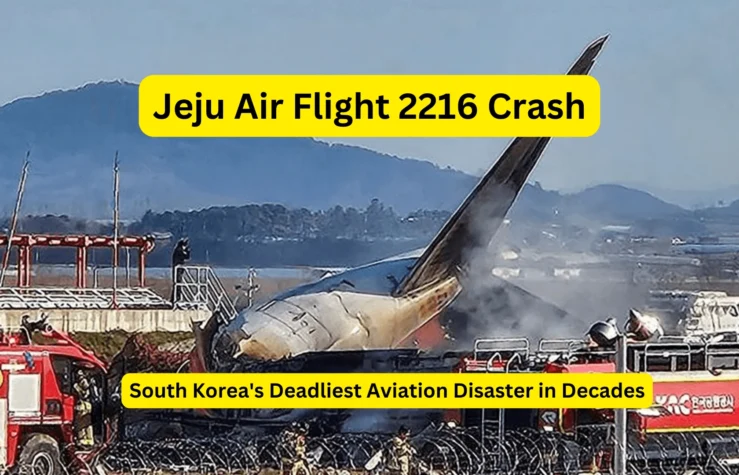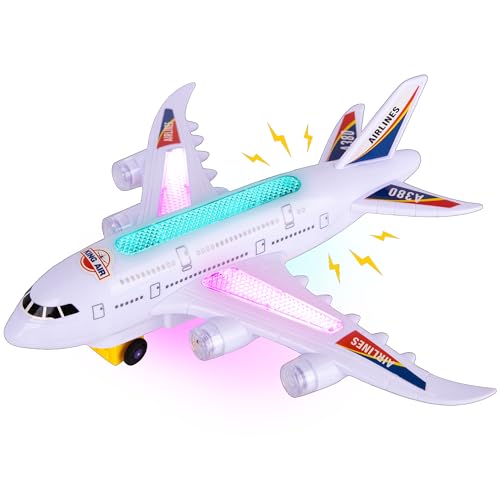On December 29, 2024, Jeju Air Flight 2216, operating a Boeing 737-800, tragically crashed during its approach to Muan International Airport in South Korea. A devastating fire was caused when the plane swerved off the runway and struck a concrete wall. Tragically, this incident resulted in the loss of at least 124 lives, making it the deadliest aviation disaster in South Korea in nearly three decades.
Flight Details
- Aircraft Model: Boeing 737-800.
- Route: The flight departed from Bangkok’s Suvarnabhumi Airport, Thailand, bound for Muan International Airport in South Korea.
- Occupants: There were 181 individuals on board, comprising 175 passengers and six crew members.
This tragic event has profoundly impacted the aviation community and the general public, prompting a thorough investigation to determine the exact cause and to prevent future occurrences.
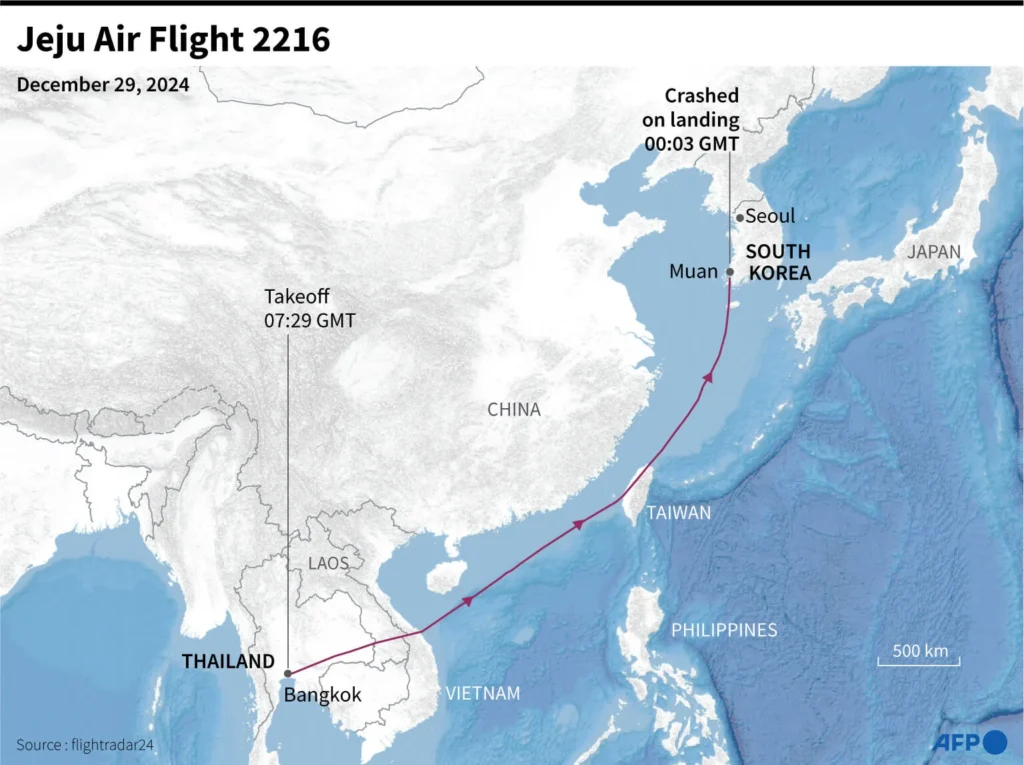
Chronology of the Crash
On December 29, 2024, Jeju Air Flight 2216, a Boeing 737-800, was on its final approach to Muan International Airport in South Korea, concluding its journey from Bangkok’s Suvarnabhumi Airport.
Timeline of Events Leading Up to the Crash
- 09:00 AM Local Time: Flight 2216 was cleared for landing at Muan International Airport.
- 09:03 AM: The aircraft attempted its initial landing approach. Due to unspecified complications, this attempt was aborted, and the crew initiated a go-around procedure.
- 09:07 AM: During the second landing attempt, the aircraft descended towards the runway. Eyewitnesses and preliminary data indicate that the landing gear was not deployed.
Description of the Landing Attempt and Subsequent Runway Excursion
As Flight 2216 approached the runway without deployed landing gear, the aircraft made contact with the runway surface in a belly-landing configuration. This unconventional landing led to a loss of directional control, causing the aircraft to veer off the designated runway path. The plane skidded across the tarmac, unable to decelerate effectively due to the absence of landing gear and compromised braking capabilities.
Details of the Collision with the Concrete Wall and Ensuing Fire
After departing from the runway, the aircraft continued its uncontrolled trajectory until it collided with a concrete wall at the airport’s perimeter. The impact with the wall resulted in significant structural damage to the fuselage, leading to a rupture of fuel tanks. The released fuel ignited almost immediately, engulfing the aircraft in flames. Emergency response teams were dispatched promptly; however, the intensity of the fire and the rapid spread hindered rescue operations. Tragically, out of the 181 individuals on board, only two survivors were reported, both sustaining severe injuries.
This catastrophic event stands as a somber reminder of the critical importance of stringent safety protocols and the unpredictable nature of aviation emergencies.
Casualties and Survivors
The tragic crash of Jeju Air Flight 2216 resulted in significant loss of life and posed substantial challenges for rescue and identification efforts.
Number of Fatalities Reported
Out of the 181 individuals on board—comprising 175 passengers and six crew members—at least 124 fatalities have been confirmed. As more bodies are found and recovery efforts continue, the death toll is anticipated to increase.
Information on Survivors and Their Current Medical Status
Remarkably, two survivors were rescued from the wreckage: a male passenger and a female crew member. Both sustained severe injuries, including burns and fractures, and were promptly transported to a nearby medical facility. They are currently receiving intensive medical care, with their conditions listed as critical but stable. Medical teams are closely monitoring their progress, providing necessary treatments, and offering psychological support to aid in their recovery.
Efforts in Identifying Victims and Notifying Families
The process of identifying the deceased has been arduous due to the extensive damage caused by the fire. Authorities have employed various methods, including dental records, DNA analysis, and personal belongings, to establish positive identifications. Specialized disaster victim identification (DVI) teams are working meticulously to ensure accuracy and dignity in the process.
Concurrently, efforts to notify the families of victims are being conducted with utmost sensitivity. Support centers have been established to provide information, counseling, and assistance to the bereaved. Jeju Air has pledged comprehensive support to the affected families, including covering funeral expenses and offering psychological counseling services. This incident has profoundly impacted the nation, prompting a unified response to support the victims’ families and a commitment to uncovering the causes to prevent future tragedies.
Preliminary Investigation Findings
The tragic crash of Jeju Air Flight 2216 has prompted an intensive investigation to determine the underlying causes of the accident.
Potential Causes Identified
Initial assessments suggest that a bird strike during the aircraft’s approach to Muan International Airport may have led to a malfunction of the landing gear. This malfunction is believed to have prevented the landing gear from deploying properly, necessitating an attempted belly landing. The absence of functional landing gear likely contributed to the aircraft skidding off the runway and colliding with a concrete wall, culminating in a catastrophic fire.
Statements from Aviation Authorities and Jeju Air Representatives
South Korean aviation authorities have acknowledged the possibility of a bird strike causing the landing gear failure but emphasize that the investigation is ongoing. They have committed to a thorough examination of all potential factors, including mechanical issues and human factors, to ascertain the precise cause of the crash.
Jeju Air’s CEO has publicly expressed profound sorrow over the incident, stating, “I take full responsibility.” The airline has pledged full cooperation with investigative bodies and has initiated internal reviews to assess and enhance safety protocols.
Overview of the Ongoing Investigation Process
The investigation is being led by South Korea’s Aviation and Railway Accident Investigation Board (ARAIB), with support from international aviation safety organizations. Key components of the investigation include:
- Data Analysis: Retrieval and examination of flight data recorders (black boxes) to analyze flight parameters and cockpit communications.
- Site Examination: Detailed inspection of the crash site to gather physical evidence, including assessment of the wreckage and identification of any foreign object debris that could indicate a bird strike.
- Maintenance Records Review: Evaluation of the aircraft’s maintenance history to identify any prior issues with the landing gear or related systems.
- Crew Interviews: Interviews with surviving crew members and air traffic control personnel to gain insights into the events leading up to the crash.
The ARAIB has stated that a preliminary report will be released once initial findings are corroborated, with a comprehensive final report to follow upon the conclusion of the investigation. In the interim, they have advised caution against premature speculation regarding the causes of the accident. This meticulous investigative process aims to uncover the factors contributing to the tragedy and to develop recommendations to prevent similar incidents in the future.
Impact on Muan International Airport Operations
The catastrophic crash of Jeju Air Flight 2216 at Muan International Airport has significantly disrupted airport operations, necessitating immediate and comprehensive responses to manage the aftermath and restore normalcy.
Immediate Suspension of Flights and Airport Activities
In the wake of the accident, all flight operations at Muan International Airport were immediately suspended to facilitate emergency response efforts and ensure the safety of all personnel. This suspension allowed unobstructed access for rescue teams and investigators to the crash site. Passengers scheduled for arrival or departure were promptly informed, and airlines coordinated alternative arrangements, including rerouting flights to nearby airports and assisting passengers with rebooking and accommodations.
Measures Taken to Manage the Aftermath and Ensure Safety
The airport authorities, in collaboration with national emergency services, implemented several measures to address the crisis:
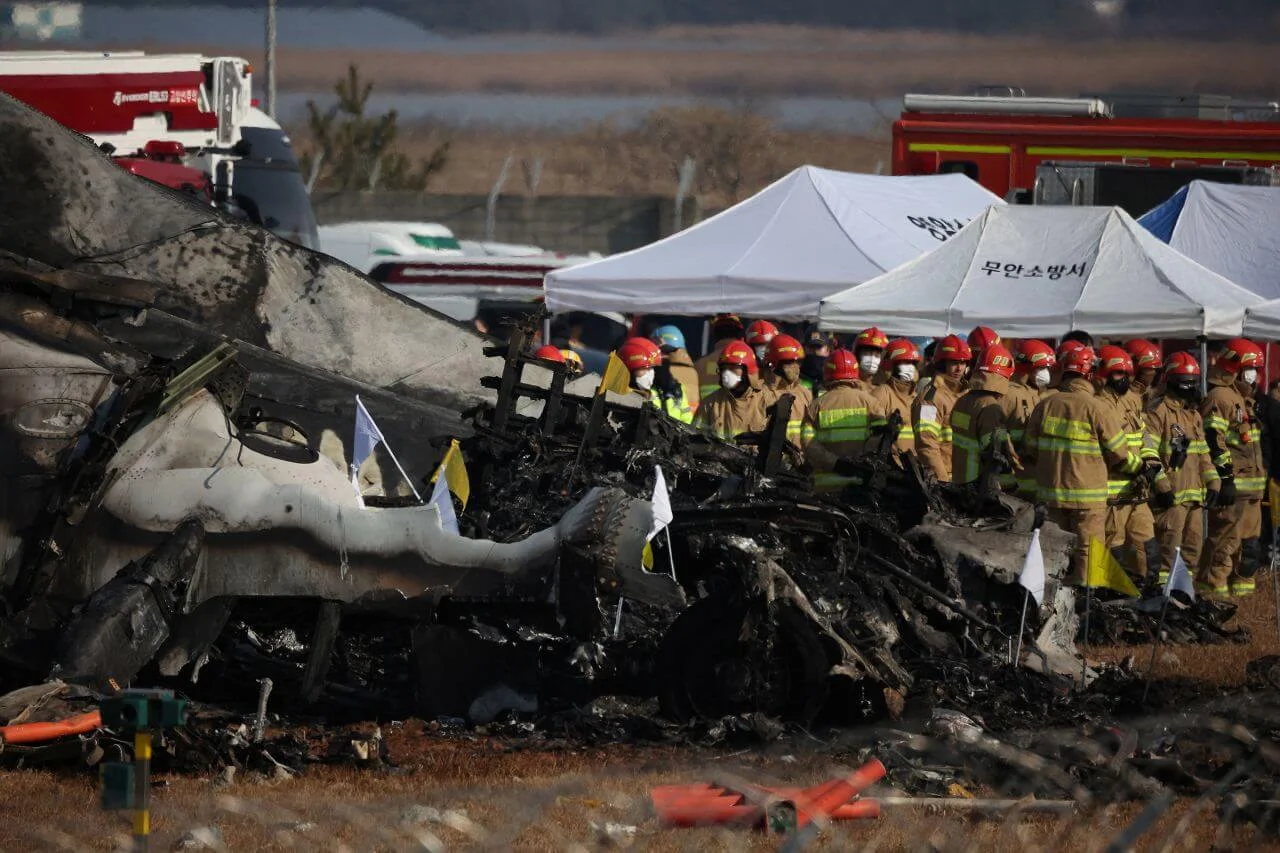
- Emergency Response: Firefighting units and medical teams were deployed immediately to control the blaze and attend to survivors. Despite their swift action, the intensity of the fire posed significant challenges.
- Site Securing and Investigation: The crash site was cordoned off to preserve evidence for investigation. Specialized teams commenced a thorough examination to determine the cause of the accident.
- Support for Affected Families: Facilities were established within the airport to provide information, counseling, and support to the families of victims and survivors. Jeju Air and airport staff coordinated efforts to offer assistance during this distressing time.
- Infrastructure Assessment: Engineering teams conducted structural assessments of the runway and surrounding facilities to evaluate damage and ensure safety before resuming operations.
Plans for Resuming Normal Operations
Restoring full functionality to Muan International Airport is a priority, approached with meticulous attention to safety and regulatory compliance:
- Runway Repairs and Safety Checks: Comprehensive inspections and necessary repairs of the runway and affected infrastructure are underway. Only upon meeting stringent safety standards will the facilities be cleared for use.
- Coordination with Airlines: Airport authorities are in constant communication with airlines to plan the resumption of flights. A phased approach is anticipated, initially accommodating cargo and domestic flights, followed by international services.
- Regulatory Approval: The reopening plan is subject to approval by aviation regulatory bodies, ensuring all safety protocols are rigorously implemented.
- Public Communication: Regular updates are being provided to the public and stakeholders regarding the status of airport operations, expected timelines for reopening, and any interim arrangements.
While the exact timeline for resuming full operations remains tentative, the commitment to safety and thoroughness underscores all efforts to restore Muan International Airport’s services following this unprecedented tragedy.
Government and Public Response
The tragic crash of Jeju Air Flight 2216 has elicited profound reactions from both the South Korean government and the public, marked by official statements, national mourning, and comprehensive support initiatives for those affected.
Statements from South Korean Officials
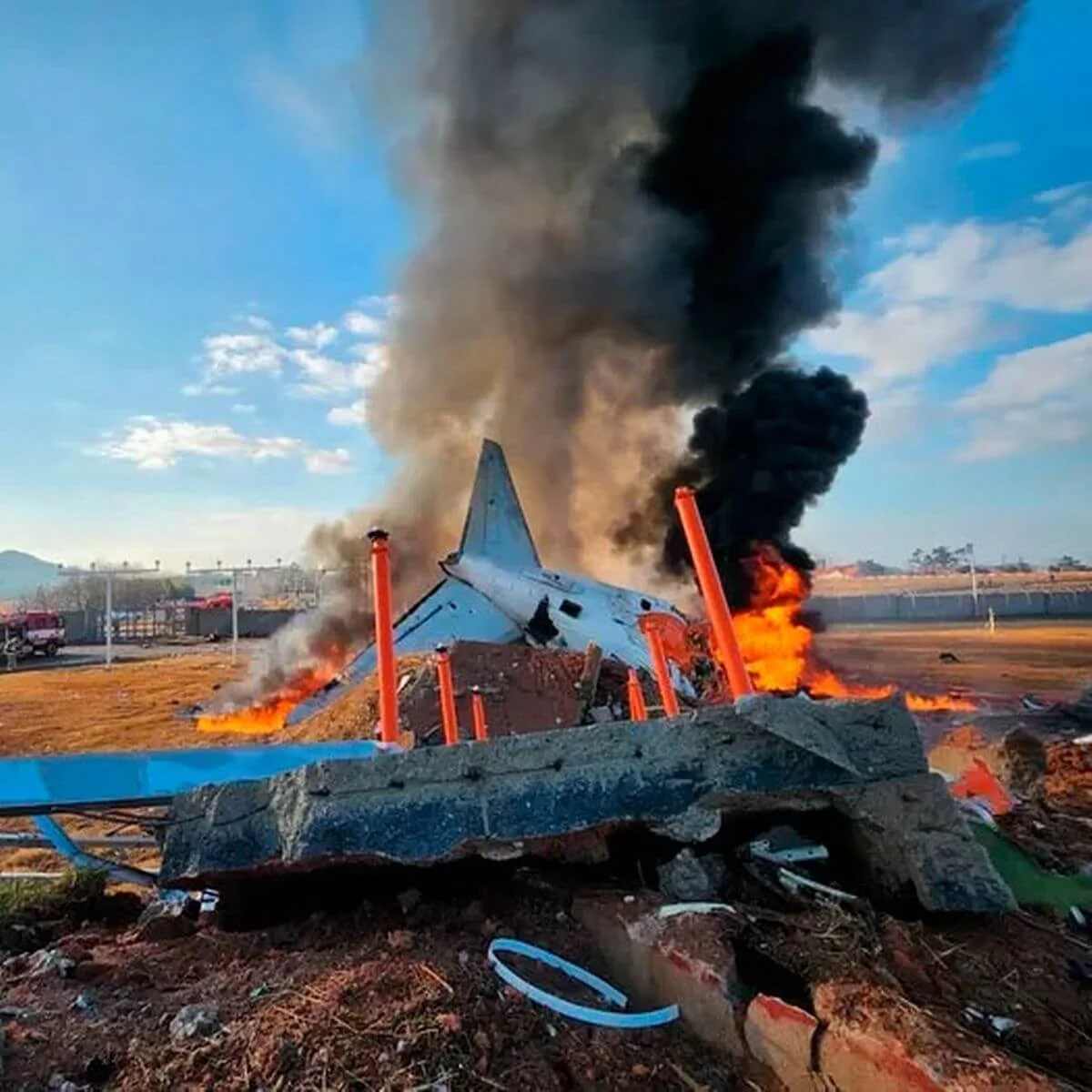
In the immediate aftermath of the disaster, Acting President Choi Sang-mok addressed the nation, expressing deep sorrow and extending condolences to the families of the victims. He emphasized the government’s commitment to mobilizing all necessary resources for rescue and recovery operations, stating, “We will spare no effort in our response to this tragedy.” Choi also called for a thorough investigation to determine the cause of the crash and to implement measures to prevent future occurrences.
Public Reaction and National Mourning
The incident has profoundly impacted the South Korean populace, leading to a nationwide period of mourning. Vigils have been held in various cities, with citizens gathering to pay their respects to the victims. Social media platforms are inundated with messages of condolence and solidarity, reflecting the collective grief and empathy of the nation. Memorial services are being organized, and flags have been flown at half-mast as symbols of mourning.
Support Initiatives for Victims’ Families and Affected Individuals
In response to the tragedy, both governmental and non-governmental organizations have launched support initiatives to assist the victims’ families and those affected:
- Financial Assistance: The government has announced compensation packages for the families of the deceased and injured, aiming to alleviate the immediate financial burdens faced during this difficult time.
- Counseling Services: Psychological support is being provided to survivors, families, and witnesses to help them cope with trauma and grief. Hotlines and counseling centers have been established nationwide.
- Logistical Support: Assistance with funeral arrangements, transportation, and other logistical needs is being coordinated to support the bereaved families.
- Community Solidarity: Local communities have mobilized to offer support, including organizing blood donation drives, providing meals, and offering accommodation to relatives traveling from afar.
These concerted efforts reflect a unified national response, underscoring the resilience and compassion of South Korean society in the face of this unprecedented tragedy.
Jeju Air’s Safety Record and Company Profile
Jeju Air, established in 2005, has grown to become South Korea’s largest low-cost carrier (LCC), playing a pivotal role in the country’s aviation sector.
Background Information on Jeju Air
As a subsidiary of the Aekyung Group, Jeju Air commenced operations with the objective of offering affordable air travel options, thereby stimulating both domestic and international tourism. The airline operates a fleet of Boeing 737-800 aircraft, renowned for their safety and efficiency. With primary hubs at Jeju International Airport and Gimpo International Airport in Seoul, Jeju Air provides an extensive network of routes connecting major cities across Asia, including destinations in Japan, China, the Philippines, and Thailand.
Overview of the Airline’s Safety History Prior to This Incident
Prior to the unfortunate incident involving Flight 2216, Jeju Air maintained a commendable safety record, with no fatal accidents reported since its inception. The airline adhered to international safety standards and underwent regular audits to ensure compliance with aviation regulations. Its fleet of Boeing 737-800s was subject to routine maintenance and inspections, contributing to its reputation as a reliable carrier within the region.
Potential Implications for the Airline’s Future Operations
The recent tragedy marks a significant deviation from Jeju Air’s previously unblemished safety record and is expected to have several implications:
- Operational Reviews: In response to the incident, Jeju Air is likely to conduct comprehensive internal reviews of its operational protocols, maintenance procedures, and safety measures to identify any areas requiring enhancement.
- Regulatory Scrutiny: Aviation authorities may impose heightened scrutiny on the airline’s operations, potentially leading to more frequent inspections and evaluations to ensure adherence to safety standards.
- Public Perception: The accident may impact public confidence in the airline, influencing passenger choices and affecting Jeju Air’s market share in the highly competitive LCC sector.
- Financial Repercussions: The combination of potential legal liabilities, compensation claims, and a possible decline in passenger numbers could pose financial challenges for the airline in the near term.
To mitigate these implications, Jeju Air will need to demonstrate transparency in the investigation process, implement any recommended safety improvements promptly, and engage in effective communication strategies to rebuild trust with the traveling public.
Comparative Analysis with Past Aviation Disasters
The tragic crash of Jeju Air Flight 2216 on December 29, 2024, has drawn comparisons to previous aviation accidents in South Korea, notably the Korean Air Flight 801 disaster in 1997.
Comparison with Previous Aviation Accidents in South Korea
Korean Air Flight 801, a Boeing 747-300, crashed on August 6, 1997, during its approach to Guam’s Antonio B. Won Pat International Airport, resulting in 229 fatalities out of 254 occupants. The National Transportation Safety Board (NTSB) attributed the primary cause to pilot error, specifically the captain’s decision-making during a non-precision approach, compounded by inadequate communication among the flight crew.
In contrast, the preliminary investigation into Jeju Air Flight 2216 suggests a possible bird strike leading to landing gear failure, culminating in a runway excursion and collision with a concrete wall. While both incidents resulted in significant loss of life, the underlying causes appear to differ, highlighting the multifaceted nature of aviation safety challenges.
Discussion on Improvements in Aviation Safety and Lessons Learned
Following the 1997 disaster, South Korea implemented substantial reforms to enhance aviation safety. These measures included:
- Regulatory Overhaul: The establishment of more stringent oversight mechanisms and adherence to international safety standards.
- Pilot Training Enhancements: Improved training programs focusing on cockpit resource management and decision-making skills.
- Technological Upgrades: Investment in advanced navigation and communication systems to aid pilots during critical flight phases.
These efforts contributed to a significant reduction in aviation accidents over the past two decades, reflecting a commitment to continuous improvement in safety protocols.
Conclusion
The Jeju Air Flight 2216 tragedy serves as a somber reminder of the inherent risks in aviation and underscores the importance of vigilance in safety practices. While South Korea has made commendable strides in enhancing aviation safety since the 1997 Korean Air disaster, this recent incident highlights the need for ongoing assessments and adaptations to emerging challenges.
The impact on South Korea’s aviation industry is profound, potentially affecting public confidence and prompting regulatory bodies to re-evaluate existing safety measures. It is imperative that the ongoing investigations into the causes of the Jeju Air crash are thorough and transparent, with findings leading to actionable insights aimed at preventing future occurrences.
In the wake of this tragedy, the aviation community must reaffirm its commitment to safety, learning from past incidents to build a more secure future for air travel.

